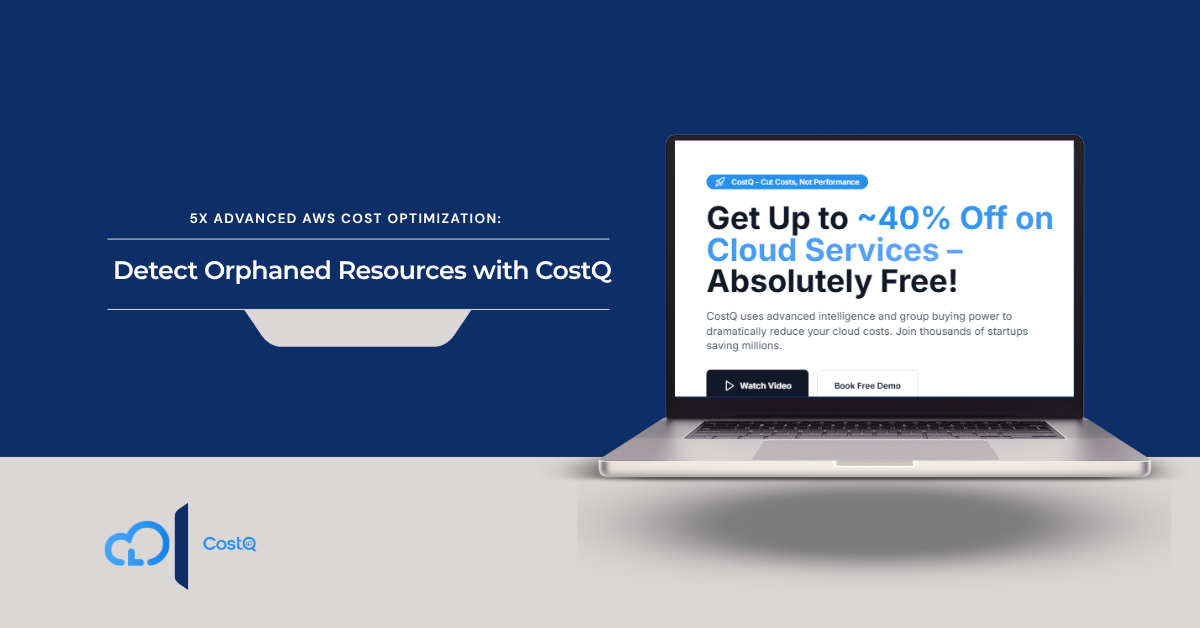Advanced AWS cost optimization starts with visibility—identifying and eliminating orphaned resources is a crucial first step toward reducing unnecessary cloud spend.
Cloud platforms like Amazon Web Services (AWS) have revolutionized the way businesses build, deploy, and scale applications. Great scalability, however, comes with great responsibility—particularly when it comes to the management of cloud costs.
One of the least explored drivers of cloud inefficiency when it comes to costs is orphaned and idle resources—services that incur charges even when they’re idle. These unseen AWS resources—like unattached Amazon EBS, idle compute capacity, and unattached Elastic IPs—can sneak up on your budget.
This guidebook will show you how to utilize AWS Config and CostQ.ai to detect, evaluate, and eliminate orphaned AWS resources and achieve significant cost savings. By the end of it, you’ll have an active cloud financial management strategy and long-term cost optimization strategy.
What are Orphaned AWS Resources?
Orphaned resources are AWS components which are still running but no longer serving any real function. They’re typically leftovers from failed deployments, abandoned test environments, or not correctly tracking resource ownership.
Common Examples of Orphaned Resources:
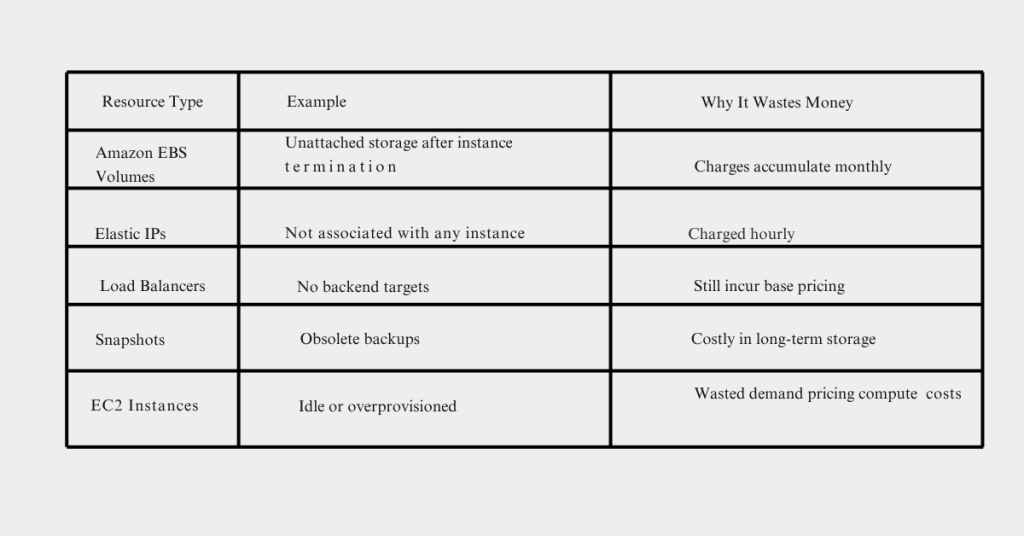
These idle or unused services inflate costs and utilization numbers—and can translate to hundreds or thousands of dollars of unnecessary cloud spend annually.
Why You Need an Idle Resource Detection Strategy for Advanced AWS Cost Optimization?
Without a good plan for tracking resource usage, organizations have a tendency to:
• Overpay for on-demand instances when Savings Plans and Reserved Instances are the more appropriate choice.
• Leave behind unused storage like EBS volumes, which adds to storage bloat.
• Miss out on visibility into data transfer costs and unutilized compute resources.
That’s where services like AWS Config and CostQ.ai come in—delivering visibility, automation, and proactive alerts to reduce cost and improve your cloud financial management posture. Enter AWS Config
What is AWS Config?
AWS Config is a native Amazon Web Services feature that continuously tracks and monitors configurations of your AWS resources. It captures changes, detects non-compliance, and supports automated resource auditing.
Key Benefits:
•It Maintains a complete history of configurations.
•It Provides compliance evaluation with built-in and custom rules.
•It Supports multi-account and multi-region aggregation.
•It Helps to detect misconfigured or unused resources.
Getting Started with AWS Config
1. Open AWS Console → Go to AWS Config.
2. Click “Set Up AWS Config” and:
- Select “Record all resources” (recommended).
- Specify an S3 bucket for storing snapshots.
- Create a service-linked IAM role.
3.Enable AWS Config Rules.
Use Managed Rules for Idle Resource Detection
These predefined rules help detect commonly orphaned resources
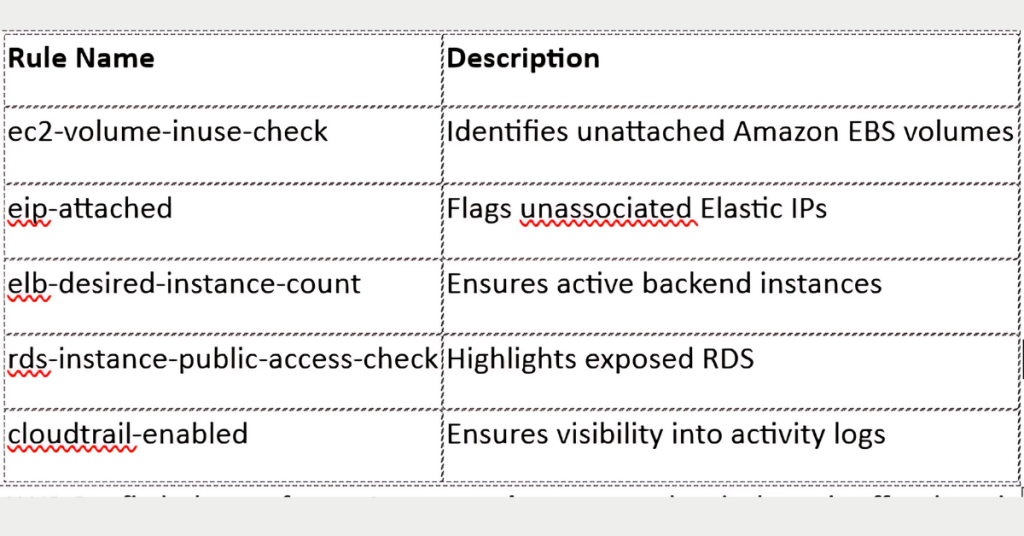
AWS Config helps surface mismanaged resources, but it doesn’t offer deep insights into costs, savings plans, or historical usage trends.
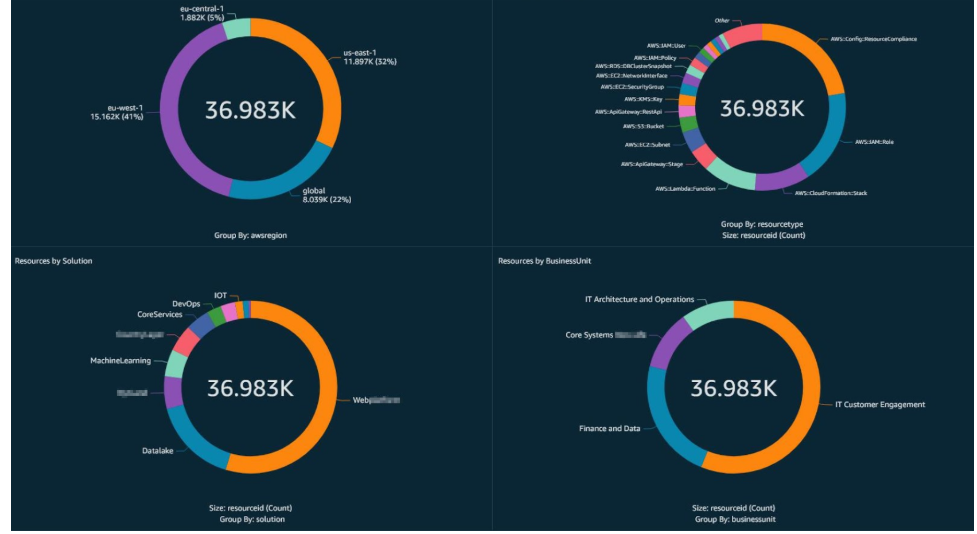

Enter CostQ.ai: The Smart Advanced AWS Cost Optimization Engine
What is CostQ ?
CostQ.ai is a cloud-first, cloud-only solution built for one purpose: cloud cost optimization. AI-driven, it augments AWS tools with smarter analysis of resource utilization, cost visibility, and actionable cost management recommendations.
Key Features:
•Unused Resource Discovery: Identifies unused EC2 instances, EBS volumes, and more.
•Historical Cost Trends: See how your cloud costs evolve over time.
•Right-Sizing Recommendations: Optimize workloads to the optimum instance types and pricing schemes.
•Multi-Account Views – Ideal for cost control by multiple business units or customers.
•Trusted Advisor Insights – Combines AWS Trusted Advisor alerts with regard to performance, security, and cost savings.
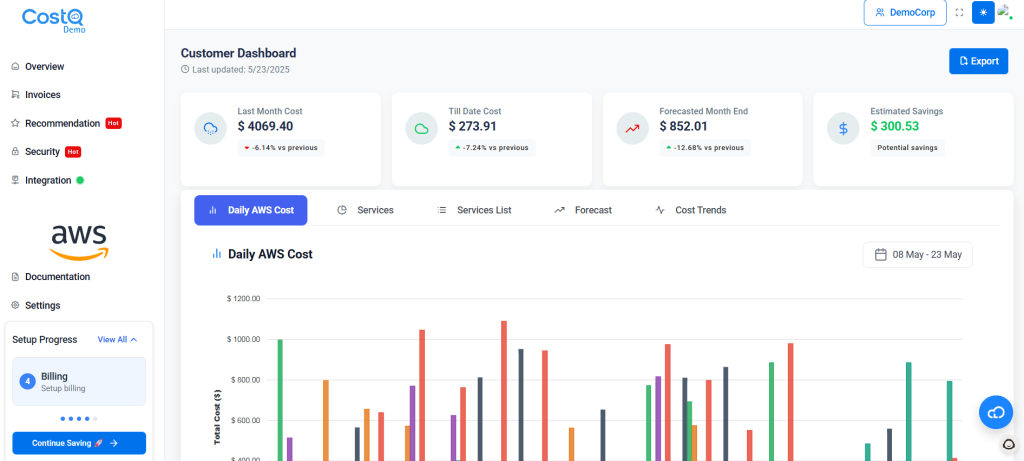
How AWS Config + CostQ.ai Work Together for advanced aws cost optimization?

Together, they create a comprehensive cost control system—covering both technical and financial dimensions
Step-by-Step Workflow: Finding and Cleaning Up Orphaned Resources
✅ Step 1: Enable AWS Config
- Enable for all regions globally.
- Set up config aggregators for multi-account awareness.
- Add managed rules for idle and non-compliant resources.
Step 2: Connect Your AWS Account to CostQ.ai
- Go to CostQ.ai and sign up.
- Create a workspace and perform guided IAM role setup.
- Connect your AWS accounts and allow 10–15 minutes to analyze.
Step 3: Check Idle Resource Reports
From the CostQ.ai dashboard, you’ll gain access to insights such as:
• EC2 Right-Sizing: “Instance i-0123 is running at <5% CPU for 10 days. Downgrade to t3.micro to save $80/month.”
• Amazon EBS Volumes: “Volume vol-4567 has been unattached for 30 days. Estimated waste: $15/month.”
• Elastic IPs: “3 unused IPs found. Estimated waste: $3.60/month.”
You can filter by:
• Region
• Account
• Resource type
• Potential cost savings
Step 4 : Take Action
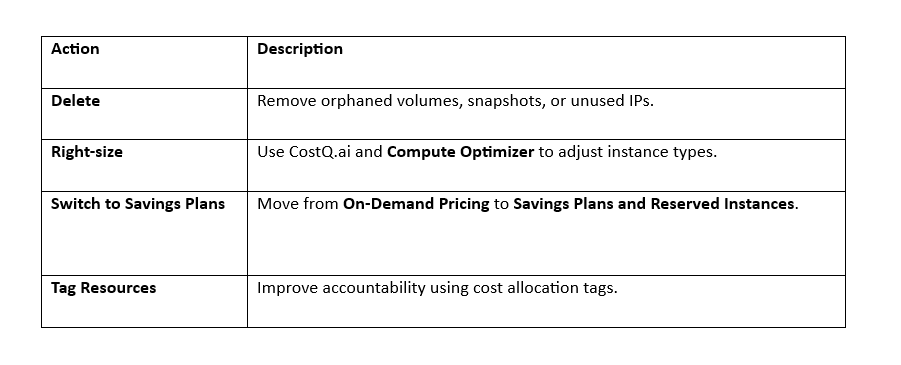
Step 5: Automate and Monitor
•AWS Config: Schedule compliance checks.
•CostQ.ai Alerts: Week summary reports on idle resources.
•CloudWatch + Lambda: Auto-delete unused EBS volumes after 7 days of inactivity.
•Cost Explorer Integration: Report historical spending and use with estimated savings.
Pro Tip: Integrate with AWS Compute Optimizer and Trusted Advisor
To go even deeper:
Utilize Compute Optimizer to determine optimal instance types for specific workloads.
Utilize AWS Trusted Advisor to obtain performance, security, and fault-tolerance recommendations and cost-saving scenarios.
Case Study: A SaaS Startup Saves 38% of Cloud Costs in 3 Weeks
Company: Mid-sized Southeast Asian SaaS platform
Problem: AWS bill increased 40% YoY without commensurate growth in usage
Solution:
- Deployed AWS Config on 5 accounts and 3 regions.
- Integrate with CostQ.ai for usage-based insights
Action taken:
- Found 43 unattached EBS volumes.Removed 11 idle EC2 instances.
- Migrated 65% of usage of demand into Savings Plans.
- Result: $2,100/month in savings + increased resource visibility
Summary Table: AWS Idle Resource Optimization Stack
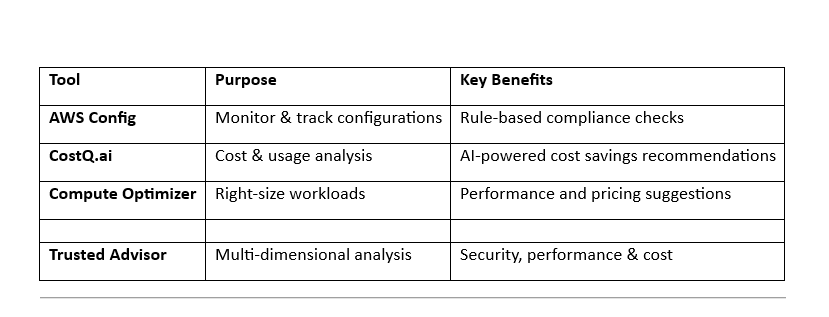
Conclusion
Effective AWS cost optimization doesn’t necessarily involve getting discounts or using Savings Plans — it begins with full visibility into your cloud environment. One of the most under-valued drivers of wasted spend is orphaned and unused resources, quietly contributing to your monthly AWS invoice.
Through the use of AWS Config to monitor resources in real time and combining it with AI-driven cost analysis and optimization recommendations of CostQ.ai, you can automatically detect inefficiencies, remove unused resources, and establish proactive fiscal management.
Start today by reviewing your AWS environment, incorporating smart cost optimization tools, and automating the management of standby resources. It’s a simple, scalable road to increased cloud efficiency and keeping your AWS costs in line — while setting the stage for sustainable, long-term cloud financials.
FAQs
What is the Config Rule in AWS?
An AWS Config Rule acts like an automated compliance checker for your cloud infrastructure. It monitors AWS resources and flags any configurations that don’t match your organization’s standards or best practices.
- For instance, you might set up a rule to make sure all EBS volumes are encrypted, or to confirm that only approved EC2 instance types are being used within your environment.
- You’ve got options: AWS offers a catalog of managed rules ready to go, or you can develop custom rules yourself using AWS Lambda functions if you need something more tailored.
In short, Config Rules help ensure your cloud resources stay in line with security policies and operational requirements, and they’ll alert you whenever something drifts out of bounds.
What is the AWS Config Service Used For?
AWS Config acts as a centralized tracking and auditing tool for your AWS resources. It systematically monitors configuration changes, logs every adjustment, and highlights deviations from established best practices or internal policies.
If you need to investigate who made specific changes or when configurations shifted, AWS Config provides a clear audit trail.
This service is essential for maintaining compliance, supporting security audits, and troubleshooting operational incidents. By offering a comprehensive inventory and detailed history of resource configurations, AWS Config enables you to maintain control and visibility across your cloud infrastructure.
Is AWS Config Real Time?
Alright, let’s dial up the tech-speak a bit. Here goes:
AWS Config isn’t pushing out changes in real-time down to the millisecond, but for most practical purposes, it’s pretty responsive. Generally, when you make a change to a supported resource, Config will pick it up and log it within a few minutes—so, not instantaneous, but close enough for most operational needs.
When it comes to compliance checks with Config Rules, those can kick off as soon as a change gets detected (triggered evaluations), or you can configure them to run on a schedule, like every 24 hours. Flexibility’s there, depending on how critical your monitoring is.
So no, you’re not getting live-streamed updates every split second, but for governance and visibility into your AWS environment? It’s more than sufficient.
What is the AWS Config File Used For?
Ah, this one’s a bit of a twist! When we talk about the AWS config file, we’re usually referring to the configuration file that you find on your local machine for the AWS CLI or SDKs.
You can typically find this file at: ~/.aws/config It’s where you store your CLI or SDK configuration settings, such as: – Your default AWS region – The format for CLI output – Named profiles for different AWS accounts
[default] region=us-east-1 output=json [profile marketing-account] region=ap-southeast-1 output=text
You may Find These Blog useful:
EC2 Savings plan analysis: Spot vs. On-Demand vs. Savings Plans at Scale
AWS Compute Savings Plans: 7 Powerful Ways to Maximize Cloud Savings in 2025
Mastering AWS Resource Visibility & Governance with AWS Config
